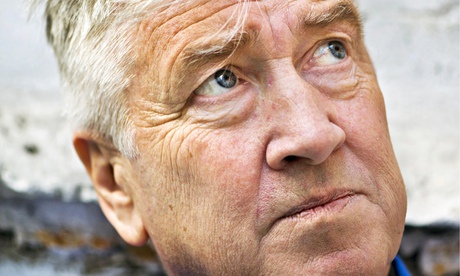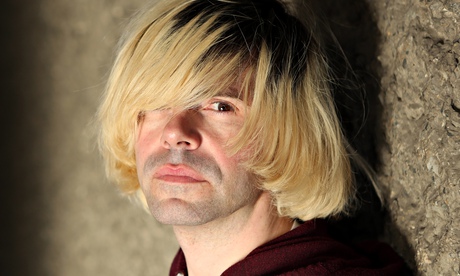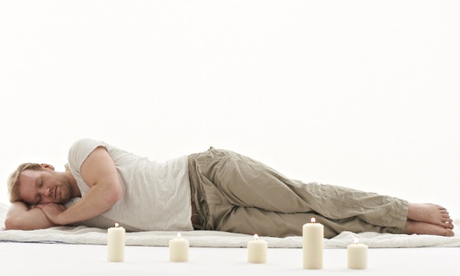I don’t know about you, but I am knackered. I wake up knackered, and spend each morning limply punching away at the fog inside my skull. I eat lunch knackered, then swear at every inanimate object in front of me. I try not to fall asleep at my desk, then stagger to my sofa, pass out in my clothes and crawl into bed for another night of infuriatingly broken sleep. That is my life. It’s not like I even do very much.
I daren’t complain about this out loud, of course, because I don’t want to get into a game of competitive exhaustion with anyone. I don’t want to tell somebody that I had four hours’ sleep, because they’ll reply that they had only three, plus their mattress caught fire at midnight. Worse, what if they’re a new parent? “How are you?” they’ll ask. “Bit tired,” I’ll reply. “Oh yeah?” they’ll snap back. “Well, I haven’t slept since October because I’ve been scraping baby diarrhoea off my fridge door with a spatula.” You can’t win with new parents.
But I am tired, and I blame myself. Like most people I know, my life has fallen into the quicksand of modernity, filled with a whirl of televisions and phones and sirens and emails and Twitter and lights and noise and bleeps. Simpsons quotes, video game sound effects and fairground music riverdance madly across the surface of my brain. Switching off takes deliberate effort, and even then it doesn’t always work. I’ll almost be asleep and suddenly my mind will shriek: “Have you remembered to set your alarm?” or, “You didn’t reply to that woman yesterday, you idiot” or, “Remember the Nyan Cat song? No? OK, I’m going to repeat it over and over again at the top of my voice until 6am, hope that’s cool.”
To shut out the world, I have turned to transcendental meditation. This was not my first choice. First I tried the sleep app Pzizz, where you get bombarded by binaural sound effects until you drop off. This didn’t work because I was convinced it would subliminally order me to eat my parents in my sleep. Then I tried flotation tanks, where you lie inside a tiny pod full of salty water for an hour. This didn’t work because it turns out that splashing around inside a dark plastic coffin full of boiling hot tears is the precise opposite of relaxing. After that, I tried mindfulness.
Chances are you’ve already heard of mindfulness, because people won’t shut up about it. Once, Buddhists and monks had mindfulness all to themselves, as a way of concentrating on their thought processes during meditation. Now that we’ve found a way of stripping out the spiritual aspect, it’s everywhere. There are books. There are seminars. Therapists and counsellors prescribe it. There are apps, like the incredibly popular Headspace, where you’re guided through 10 minutes of breathing exercises and top-down self-diagnostic checks on various parts of your body until you become the perfect model of beaming self-realisation.
Mindfulness helps thousands of people every day; people with depression and eating disorders and addiction problems. But it’s not for me. Mindfulness requires self-observation, and self-observation is exhausting. You have to sit and pay attention to everything. How you’re breathing, what your posture’s like, what you’re thinking about, why you’re thinking about it, what to do because you’re thinking about whatever you’re thinking. It goes on and on. I know people who have been put on mindfulness courses by doctors, only to run away screaming at the piles of homework they’re expected to do.
 The modern-day resurgence of TM is often attributed to the work of film director David Lynch, whose foundation teaches TM techniques to a number of at-risk groups. Photograph: Linda Nylind for the Guardian
The modern-day resurgence of TM is often attributed to the work of film director David Lynch, whose foundation teaches TM techniques to a number of at-risk groups. Photograph: Linda Nylind for the Guardian
Plus mindfulness makes me neurotic. One exercise I did involved writing down every thought that passed through my mind over the course of half an hour. This taught me that I was worried about work. I didn’t know I had been worried about work, but the knowledge sent me into a panicky death spiral. In retrospect, I should have just pushed all my feelings down into the pit of my stomach and ignored them until they turned into heart disease and killed me at a tragically young age. This is the Heritage way.
So I turned to transcendental meditation. I was wary at first, because I clearly remember watching a party political broadcast for the Natural Law party, the politicised wing of transcendental meditation, about 20 years ago. I still remember how colossally creepy it was. There was a man with a thick Selleck tache sitting behind a desk and explaining, in a cartoonishly sinister way, how his party wanted to unite the country beneath a field of collective consciousness. There was a horrible purple mural of the galaxy, the sort of thing you find in shops that sell under-the-counter bongs to 12-year-olds. There were the Yogic Flyers, who were basically a couple of blokes flapping around on a mattress in their pyjamas. There was the claim that the Yogic Flyers had single-handedly reduced crime in Merseyside by 60%, presumably by bouncing cross-legged around Toxteth like a squadron of low-flying Batmen. Some of us tried to yogic-fly up and down the CDT block at school the next day. It did our knees in.
The Natural Law party looked like the smug dinner party guest who had it all figured out and wanted to condescend you into submission. But times change. The Natural Law party deregistered a decade ago. Every idiot’s got a beard now. More importantly, transcendental meditation has undergone an enormous PR overhaul. In recent years, it has been reframed as a practical lifestyle choice rather than something for bead-liking soap-dodgers.
According to its website, 4 million people around the world now practise it daily. It’s not even called transcendental meditation any more. They played the Kentucky Fried Chicken card, so it’s just TM.
Rather than banging on about collective consciousness, TM now sells itself as a cure for modern life. Our fight or flight responses have been mucked up, say TM’s advocates, leaving us in a constant state of stress. By spending 40 minutes a day meditating, we can learn to dim those responses a little. They point to evidence from the American Heart Association and other organisations that it lowers blood pressure and risk of heart disease. There is much anecdotal evidence that it increases creativity and efficiency. All this and you get to experience a profound sense of rest in the process.
Perhaps because it’s so beneficial – or perhaps because it sounds like a vaguely spiritual fad – a huge number of celebrities have signed on. Jerry Seinfeld does it. Martin Scorsese does it, as does Oprah Winfrey and her entire staff. Goldie Hawn led a TM session at Davos this year. Clint Eastwood does it, for crying out loud. Clint Eastwood, the opposite of a hippy, a man who shoots hippies. In this country, singer Tim Burgess of the Charlatans is a big believer in the power of TM. He has been practising since 2008, and told me it’s “one of the most important aspects of my life”. He meditates morning and evening. The morning, he says, is “a great time for ideas. Not necessarily world-changing ideas – often little ones about how to organise my day, things I have forgotten, plans and ruminations on what’s going on.”
The modern-day resurgence of TM is often attributed to the work of film director David Lynch, whose foundation teaches TM techniques to a number of at-risk groups. It helps returning soldiers deal with depression and post-traumatic stress. Under the guise of quiet time, it makes schoolchildren more productive and generally less likely to stab each other. It holds TM sessions in homeless shelters and prisons and orphanages. It has commissioned an ocean of scientific research and academic studies to back up its claims. Before he began practising TM, Lynch has said, he was “filled with worries and anxieties”. Someone had suggested psychotherapy but, scared that this might limit him creatively, he turned to TM. “When I had my first meditation,” he says, “this inner bliss revealed itself so powerfully – thick happiness came rushing in. And I said, ‘This is it.’ There it was. And everything just started getting better – way more fun, way more joy in the doing… And it just seems natural. You’re happy and there’s nothing you can do about it.”
Does TM work for non-celebrities? It seems to be having a moment among 30-somethings who are quite emphatic about how calm they are. I tracked down a couple of devotees to be sure. Again, there was no word of dissent. Marketing manager Justyna Sobkowicz started practising in 2012, and happily admits it changed her life. “When someone told me that you have to give up 20 minutes twice a day, I was suspicious,” she says. “But it calmed me down. You have less stress.” She had experimented with other types of meditation, which didn’t work. “They make you try to think you’re on a beach, and it’s an effort to imagine these things.”
 Tim Burgess has been practising transcendental meditation since 2008, and says it’s “one of the most important aspects of my life”. Photograph: Richard Saker for the Guardian
Tim Burgess has been practising transcendental meditation since 2008, and says it’s “one of the most important aspects of my life”. Photograph: Richard Saker for the Guardian
Maverick Gutarra (his real name) got into TM because he is a big fan of Lynch’s Twin Peaks. He had tried other kinds of meditation: “But after those you still go out to a bar and drink seven pints.” After learning TM a couple of years ago, he told me he was much healthier in every way: “You’re not as likely to drink a bottle of tequila every night.” Maverick talked about booze a lot. “I was raised in Sweden,” he offered by way of explanation.
But they would say this, wouldn’t they? They do TM, and they want everyone else to do it, too. I still wasn’t sure but it was time to try it for myself.
Through tm.org, I found an instructor, Ged Valente. An amiable Glaswegian schoolteacher who turned to TM decades ago, Ged explained how easy it is to learn. You can’t pick up TM from a book or an app or an article like this, because the instruction has to be customised to your individual needs. So, instead, an instructor comes to your house on four consecutive evenings. After that, you’re on your own. You don’t have to pay any more money. You don’t have to attend any more classes or meet any new TMers. You don’t even have to be that interested in religion or spirituality. Which is good, because I’m not.
Ged talked me through the difference between TM and mindfulness. Where mindfulness practises overt observation, he said, TM is all about letting go. You sit in silence for 20 minutes, and your mind naturally begins to quieten down. You repeat a mantra – a meaningless sound you’re not allowed to tell anyone – and eventually, if you’re doing it right, you reach a point of expansive silence, and your body floods with a warm and pleasant feeling.
This feeling has many names, but I’ll be referring to it as transcendence. Ged likes to call it “pure consciousness”, which is a little too mystical for me. Other people call it “bliss”, although I won’t because that word’s been hugely devalued since people started using it as a Twitter hashtag for whenever they get to eat a Twix in an armchair. So transcendence it is.
Training consists of an exploratory chat, an initiation ceremony and three follow-up sessions. Hearing that a ceremony was involved was a worry, but not a big one. As Ged said, “If you like ceremonies, it’s fun. If you don’t, it’s short.” It takes five minutes, and by the time you’re done, you’ve got your mantra.
 ‘I felt groggy after my first go. My brain didn’t quite know what to do without the usual clattering din of gibberish and retro sound effects.’ Photograph: Suki Dhanda for the Guardian
‘I felt groggy after my first go. My brain didn’t quite know what to do without the usual clattering din of gibberish and retro sound effects.’ Photograph: Suki Dhanda for the Guardian
After that, you can get on with meditating. TM, I quickly discovered, was pretty much designed for people as lazy as me. You sit down wherever you like, in your normal clothes, shut your eyes and repeat your mantra in your mind. That’s it. As time goes on, you stop feeling self-conscious, and your breathing slows down. Your grip on the mantra loosens and it grows more abstract. Your mind becomes stiller and less troubled by thought. It’s a nice feeling.
I felt groggy after my first go. My brain didn’t quite know what to do without the usual clattering din of gibberish and retro sound effects. And five minutes later, I told my sofa to go fuck itself. I can’t remember why. Inner peace was clearly some way off.
After a few attempts, though, I started to improve. Eventually it became easier to shut up my stupid brain. When you finally achieve this, everything just melts away. It feels like the instant before you fall asleep, but stretched out. I can’t say for sure that this was transcendence but it definitely calmed me. To be honest, I might have just fallen asleep – but even that is fine. You’re allowed to fall asleep in TM. It’s a sign of good practice.
The full benefits of TM don’t necessarily show themselves until you’ve been practising regularly for weeks or months – Maverick told me it took him a year – so it’s too soon to say if it has had any concrete results. I don’t know what it’s done to my blood pressure, or whether I am any less likely to keel over with a giant heart attack before the age of 35. I certainly haven’t yet experienced the shimmering, all-encompassing, unbound glow that comes with full-blown transcendence. But I’ve decided I’m going to stick with it, even if transcendence never comes.
Why? Because it’s an almost embarrassingly luxurious thing to do. Aside from anything else it means that, for 20 minutes twice a day, I get to shut myself away. There is no TV, no rolling news, no phone calls or emails or idiots squabbling about specific definitions of feminism on Twitter. Nobody is trying to sell me anything. There’s just me, alone, sitting quietly in a nice chair with my eyes closed. TM is the closest I can feasibly get to running off to live in a cave, which is something I’d like to do but probably won’t because I don’t think Domino’s delivers to caves.
More than anything else, TM works for me. It might not work for you, but I find it profoundly relaxing. It gives me a chance to order my thoughts. I’ve discovered that I can concentrate more easily throughout the day. Most importantly, whether it’s down to the meditation or some elaborate placebo effect, I am much less tired than I was a month ago. My sleep is deep and unbroken (so take that, new parents).
And best of all, I am still me. I haven’t suddenly got religion. I still don’t know what a collective consciousness is. I still swear at inanimate objects. Total relaxation and getting to call your printer a dickhead. That’s the dream, isn’t it?
Transcendental meditation: does it perform?
Hiç yorum yok:
Yorum Gönder